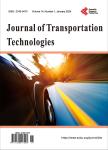Using Connected Truck Trajectory Data to Compare Speeds in States with and without Differential Truck Speeds
Using Connected Truck Trajectory Data to Compare Speeds in States with and without Differential Truck Speeds作者机构:Joint Transportation Research Program Purdue University West Lafayette USA
出 版 物:《Journal of Transportation Technologies》 (交通科技期刊(英文))
年 卷 期:2022年第12卷第4期
页 面:681-695页
学科分类:07[理学] 0701[理学-数学] 070101[理学-基础数学]
主 题:Connected Vehicle Data Trucks Differential Speed Limits Interstates
摘 要:Historically, researchers and practitioners have utilized spot speeds and microscopic simulation methodologies to evaluate the operational impact of differential or uniform speed limits for trucks and passenger vehicles. This paper presents a methodology that uses connected truck data to develop a statistical characterization of both passenger car and truck speeds. These techniques were applied to three adjacent states, Illinois, Indiana and Ohio. Illinois and Ohio have 70 mph speed limits for both trucks and cars. Indiana has a differential speed limit for heavy trucks (65 mph) and passenger cars (70 mph). The statistical distribution of truck speeds was then compared among Illinois, Indiana and Ohio. These speeds were derived from over 8 million connected truck records traveling along Interstate 70 in Illinois, Indiana and Ohio during a one-week period from May 8-14, 2022. Statistical test results over selected 20-mile sections in each state showed that median truck speeds in Indiana with its differential speed limit of 65 mph were only 1 - 2 mph lesser than the neighboring states of Illinois and Ohio who observe a uniform speed limit of 70 mph for all traffic.



